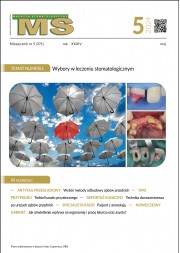Dostęp do tego artykułu jest płatny.
Zapraszamy do zakupu!
Po dokonaniu zakupu artykuł w postaci pliku PDF prześlemy bezpośrednio pod twój adres e-mail.
Orthodontic effects of palatal suture expansion
Wstęp. Celem pracy było określenie możliwości rozsunięcia szwu podniebiennego metodą ortodontyczną w zależności od wieku leczonych oraz ocena efektów ortodontycznych leczenia.
Materiał i metody. Badaniem objęto 40 pacjentów: 24 płci żeńskiej i 16 płci męskiej w wieku od 10 lat i 6 miesięcy do 30 lat i 1 miesiąca. W zależności od wieku utworzono dwie grupy.
Wyniki. Rozsunięcie szwu podniebiennego nastąpiło u 18 osób, czyli u 100% badanych z grupy I, w grupie II natomiast u 54%, tzn. u 12 osób w wieku od 16 lat i 4 miesięcy do 30 lat i 1 miesiąca. U pozostałych 10 osób nie doszło do rozsunięcia szwu podniebiennego.
Wnioski. Rozsunięcie szwu podniebiennego w sposób istotny statystycznie wpływało na przyrosty szerokości podniebienia, przyrosty przedniej i tylnej szerokości górnego łuku zębowego oraz na zmniejszenie indeksu wysokości podniebienia. Nie zaobserwowano natomiast istotnego statystycznie wpływu rozsunięcia szwu podniebiennego na obniżenie wysokości podniebienia i zmniejszenie nagryzu pionowego oraz zmiany nagryzu poziomego. Nie zaobserwowano też istotnego statystycznie wpływu wieku na zmiany ortodontyczne: szerokość podniebienia, przednią i tylną szerokość górnego łuku zębowego, indeks wysokości podniebienia, wysokość podniebienia, nagryz pionowy i poziomy. Zaobserwowano natomiast istotny statystycznie wpływ wieku na zmiany ortopedyczne oceniane na podstawie szerokości diastemy.
Introduction. The aim of the work was the determination of the possibility of the palatal suture expansion with an orthodontic method depending on the age of patients, and the assessment of orthodontic treatment results. Material and methods. The examination composed 40 individuals (24 female and 16 male) at the age of 10 and 6 months to 30 years and 1 month. Two groups were formed with regard to age. Results. The palatal suture expansion was obtained in 18 individuals (that is 100% of the examined) of the first group at the ages of 10 years and 6 months to 15 years and 5 months and in 12 individuals at the ages of 16 years and 4 months to 30 years and 1 month in the second group, which amounted to 54%. In 10 persons there was no palatal suture expansion. Conclusions. The palatal suture expansion influenced in a statistically significant way an increase in the width of the palate, anterior and posterior width of the upper dental arch and a decrease in the index of the palatal height. The palatal suture expansion had no statistically significant influence on lowering the height of the palate and on the decrease in overbite, or changes in overjet. The age had no statistically significant influence on orthodontic changes. However, the age had a statistically significant influence on orthodontic changes assessed on the basis of the width of diastema.













